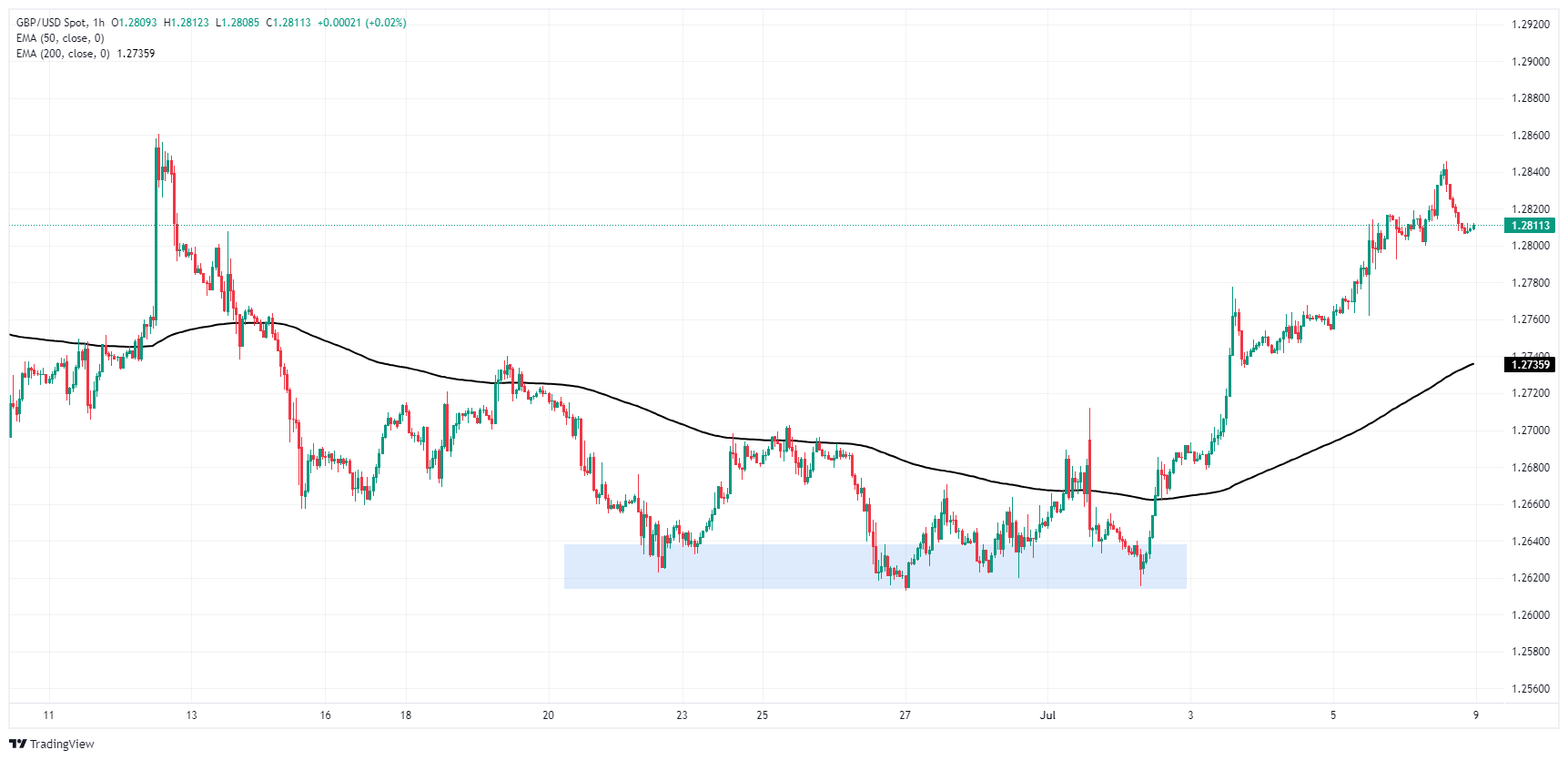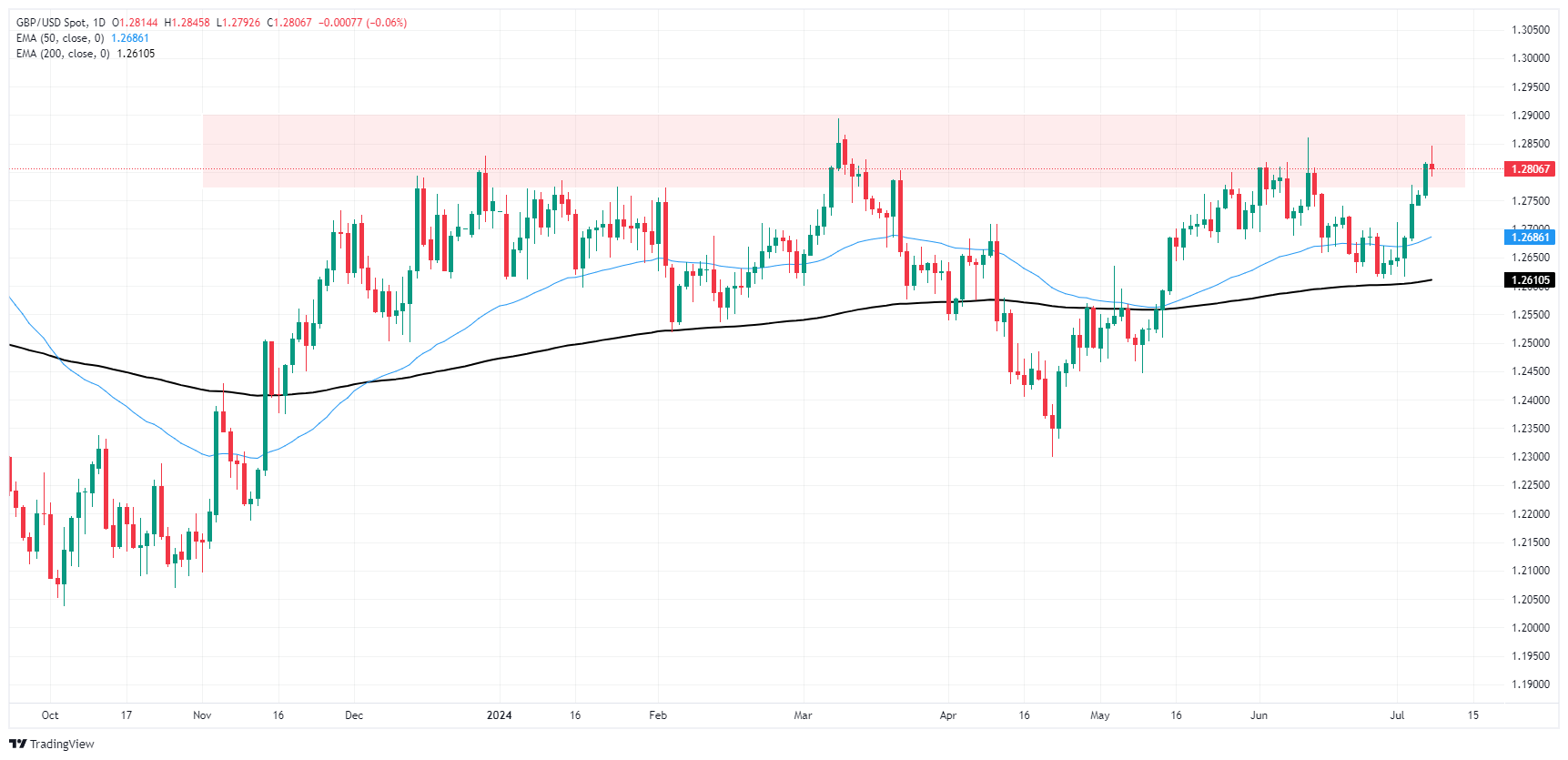GBP/USD falls back from brief peaks as Fed Powell appearance looms

- GBP/USD briefly found fresh highs above 1.2840 before slumping back on Monday.
- The first of two appearances from Fed Chair Powell is slated for Tuesday.
- Key US consumer and wholesale inflation figures due later this week.
GBP/USD briefly tested a fresh four-week high on Monday, crossing above 1.2840 before broad-market flows dragged Cable back down to the week’s opening bids just north of 1.2800. UK data remains thin this week, leaving traders grappling with peaking rate cut hopes clashing with an overly-cautious Federal Reserve (Fed) that insists on waiting for further signs that US inflation will ease towards the Fed’s 2% annual inflation target.
Forex Today: All eyes on Powell
Fed Chairman Jerome Powell will make the first of two appearances this week when he delivers the Fed’s latest semiannual Monetary Policy Report to the US Senate Banking Committee. Fed Chair Powell will follow up with a repeat performance when testifying before the Congressional House Committee on Financial Services on Wednesday.
Key US inflation data is due later in the week, with US Consumer Price Index (CPI) inflation due on Thursday and Producer Price Index (PPI) wholesale inflation slated for Friday. Traders hoping for further easing in inflation figure to help bully the Fed into rate cuts sooner rather than later may be setting themselves for disappointment later in the week with both CPI and PPI inflation figures forecast to either hold steady or tick upwards slightly.
UK data also remains limited this week, with various appearances from Bank of England (BoE) policymakers slated for Wednesday and industrial and manufacturing activity survey results on the books for Thursday. UK Industrial and Manufacturing Production are both expected to rebound in May after the previous month’s slight contraction.
Economic Indicator
Consumer Price Index (MoM)
Inflationary or deflationary tendencies are measured by periodically summing the prices of a basket of representative goods and services and presenting the data as The Consumer Price Index (CPI). CPI data is compiled on a monthly basis and released by the US Department of Labor Statistics. The MoM figure compares the prices of goods in the reference month to the previous month.The CPI is a key indicator to measure inflation and changes in purchasing trends. Generally, a high reading is seen as bullish for the US Dollar (USD), while a low reading is seen as bearish.
GBP/USD technical levels
Cable has firmly rallied after recovering from July’s early swing low towards 1.2600, but bullish momentum has stopped short of breaching June’s key peak at 1.2860. The pair is still trading on the high side of the 200-hour Exponential Moving Average (EMA) at 1.2735.
Bullish daily candles are set for a bearish turnaround as bids get set adrift within a heavy supply zone above 1.2800. Price action has so far stayed on the north side of the 200-day EMA at 1.2609.
GBP/USD hourly chart
GBP/USD daily chart
Pound Sterling FAQs
The Pound Sterling (GBP) is the oldest currency in the world (886 AD) and the official currency of the United Kingdom. It is the fourth most traded unit for foreign exchange (FX) in the world, accounting for 12% of all transactions, averaging $630 billion a day, according to 2022 data. Its key trading pairs are GBP/USD, aka ‘Cable’, which accounts for 11% of FX, GBP/JPY, or the ‘Dragon’ as it is known by traders (3%), and EUR/GBP (2%). The Pound Sterling is issued by the Bank of England (BoE).
The single most important factor influencing the value of the Pound Sterling is monetary policy decided by the Bank of England. The BoE bases its decisions on whether it has achieved its primary goal of “price stability” – a steady inflation rate of around 2%. Its primary tool for achieving this is the adjustment of interest rates. When inflation is too high, the BoE will try to rein it in by raising interest rates, making it more expensive for people and businesses to access credit. This is generally positive for GBP, as higher interest rates make the UK a more attractive place for global investors to park their money. When inflation falls too low it is a sign economic growth is slowing. In this scenario, the BoE will consider lowering interest rates to cheapen credit so businesses will borrow more to invest in growth-generating projects.
Data releases gauge the health of the economy and can impact the value of the Pound Sterling. Indicators such as GDP, Manufacturing and Services PMIs, and employment can all influence the direction of the GBP. A strong economy is good for Sterling. Not only does it attract more foreign investment but it may encourage the BoE to put up interest rates, which will directly strengthen GBP. Otherwise, if economic data is weak, the Pound Sterling is likely to fall.
Another significant data release for the Pound Sterling is the Trade Balance. This indicator measures the difference between what a country earns from its exports and what it spends on imports over a given period. If a country produces highly sought-after exports, its currency will benefit purely from the extra demand created from foreign buyers seeking to purchase these goods. Therefore, a positive net Trade Balance strengthens a currency and vice versa for a negative balance.
